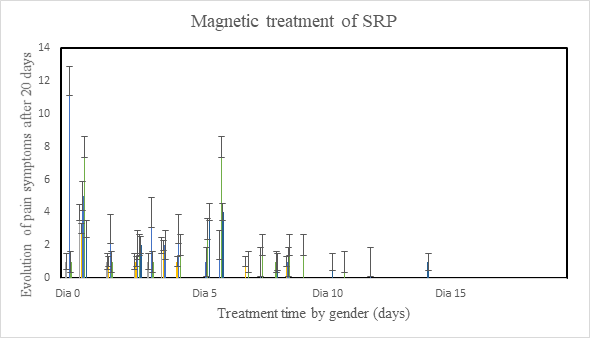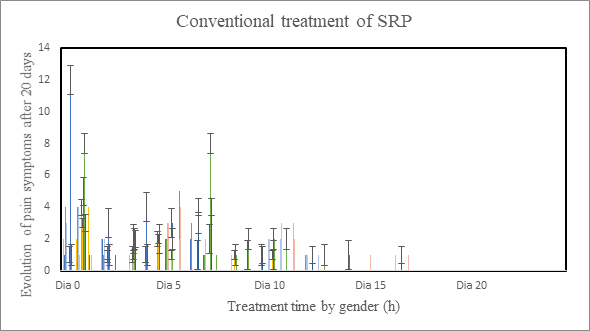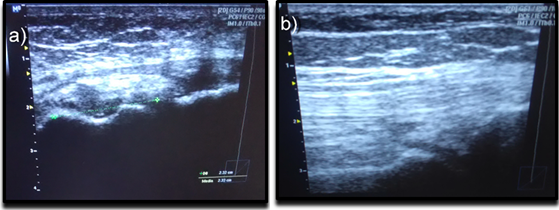MOJ
eISSN: 2574-9935


Short Communication Volume 7 Issue 1
1Centro Nacional de Electromagnetismo Aplicado, Universidad de Oriente, Cuba
2Hospital Clinico Quirurgico, Cuba
Correspondence: Leonardo Mesa Torres, Centro Nacional de Electromagnetismo Aplicado, Universidad de Oriente, Sede Julio Antonio Mella Ave, de las Américas s/n CP 4078, Santiago de Cuba, Cuba
Received: February 12, 2024 | Published: March 7, 2024
Citation: Torres LM, Salinas YR. Magnetic knee brace for treatment of knee synovitis: design and simulation. MOJ Sports Med. 2024;7(1):22-24. DOI: 10.15406/mojsm.2024.07.00157
In the last few years, many researchers have been investigating the theoretical and experimental aspects of the of the use of the electromagnetic field and its effects on living organisms, and this is evidenced by the number of scientific papers published in different journals; however, there are no reports of a therapy that combines the use of the magnetostatic field (permanent magnets) and cryotherapy for the treatment of knee synovitis. The objective of this work lies in the design and simulation of a magnetic knee brace, with permanent magnets, for the treatment of SRP. It is concluded that magnetic induction generated by the configuration of the knee brace is feasible for this pathology and with cryotherapy it has high analgesic and anti-inflammatory effectiveness, since it relieves pain and inflammation caused by knee injuries (arthritis, osteoarthritis, SRP); and accelerates the rehabilitation time of athletes/physical exercise practitioners, with respect to conventional treatment; which has a direct impact on the patient's quality of life, mainly in the work, social and economic spheres.
Keywords: magnetotherapy, ELF-EMF, knee synovitis
Knee injuries currently affect more than 90 % of the world's population; this is due to the fact that the which, influences the pain and inflammation of the patient or competitive athlete and limits his or her activities of daily living, such as: work activities, practice of medicine, and participation in competitions and family welfare, for which reason, it is considered a major health problem. Knee synovitis is defined as an inflammatory disorder of the synovial membrane of the knee joint and is usually accompanied by increased synovial fluid. The origin of SRP can be traumatic or non-traumatic. The traumatic type is the repetitive micro trauma1 and acute trauma/impact.2 Non-traumatic types can degenerative,3 infections,4 metabolic,5 autoimmune,6 rheumatic diseases (rheumatoid arthritis and juvenile arthritis),7 among others (hemophilia and pigmented nodular hairy synovitis).8,9 The types of therapy in highly competitive athletes with SRP are non-physical and physical in nature.
These therapies are essentially used as analgesics (pain relief), anti-inflammatory and regenerative therapies during the first phase of rehabilitation; when the competitive athlete arrives in pain.10 Non-physical types of therapies are analgesics (such as dipyrone or metamizole)11 nonsteroidal anti-inflammatory drugs (e.g., ibuprofen);12 regenerative drugs with factor-rich plasma (e.g., ibuprofen);12 regenerative drugs with factor-rich plasma (e.g., ibuprofen) growth;13 regenerative stem cell therapies;14 and arthrocentesis (aspiration of the synovial fluid from swollen and distended joints in order to alleviate the pain and swelling. discomfort and pain).15,16 Physical therapies may include ultrasound pulsed; thermotherapy (e.g., cryotherapy, infrared, ultraviolet); laser; electrotherapy; and electromagnetic field.17
Magnetotherapy is the therapy of different pathologies with static, variable or pulsed magnetic field that has been applied since the middle of the 20th century by several scientists around the world.18 Mesa et al., propose the design of a magnetic bed, with permanent magnets, where the therapist selects the induction and homogeneity of the magnetic field, according to the pathology (ies) to be treated, which allows an effectiveness of more than 80% with respect to conventional treatment.19
On the other hand, some authors suggest the use of the extremely low frequency electromagnetic field, called ELF-EMF (extremely low frequency electromagnetic field), as an analgesic and anti-inflammatory therapy for the treatment of pain caused by SRP. The parameters that characterize this physical agent are magnetic induction, exposure time, pulse duration, interval between pulses, and waveform (e.g., sinusoidal, square, half-wave, triangular). Esmirna et al., describe the linear and curvilinear correlations (r = 1) between the variables physical examination and ultrasound at t = 0 days and t = 20 days of the application of conventional therapy and ELF-EMF at 60 Hz; however, they do not perform the statistical analysis of the comparison between the same diagnostic variable at the beginning and at the end of the application of the therapy.20 Teresa Paolucci et al., report the use of ELF-EMF combined with an elastic knee brace that promotes functional recovery of the knee and relieves pain compared to previous therapies. In the current scientific literature, there are no reports of the use of permanent magnets and cryotherapy for the treatment of SRP.21 Font et al., describes the use of nuclear medicine in the primary diagnosis of injuries in competitive athletes and exercise practitioners, which contributes to the safe treatment of various diseases in the branch of orthopedics, but is very expensive.22 In this research, the design and simulation of a knee brace is carried out, whose magnetic system consists of permanent magnets; rectangular in shape, confined and distributed, equally and equidistantly, to the center of the magnetic configuration; which generates a unilateral and non-uniform magnetic field induction which is combined with cryotherapy for the treatment of knee synovitis present in athletes/exercisers.
The design of a magnetic system for the diagnosis and treatment of diseases is very complex. This takes into account parameters such as magnetic induction and homogeneity, which depend on the designed configuration. The calculation of the magnetic field induction was made according to the following expression.18,23,25
(1)
Where, is the magnetic field induction, μ magnetic permeability of the material, intensidad del campo magnético. A computer program was used to calculate the induction and homogeneity of the magnetic field. It was proposed to use material N 42.23
A longitudinal and controlled pilot study was performed. The patients were distributed in two groups of therapies, A longitudinal and controlled pilot study was performed. The patients were distributed in two groups of therapies, the G1 (control group) was applied the conventional therapy and G2 (study group), magnetic field + cryotherapy; 8 hours for 15 minutes, for a period of 10 days, respectively. The data will be entered into an Excel table, version 10 of Microsoft Office, in which the data will be processed. The statistical techniques used were implemented in the statistical program Minitab® 14 (Minitab Inc for Windows, 2003, free software, National Institute of Standards and Technology, Pennsylvania State University, USA, https://www.minitab.com/en-mx/products/minitabs).
Figure 1 shows the configuration of the magnetic system of the magnetic knee brace, to permanent magnets and Figure 2 shows the magnetic field induction map.

Figure 1 Magnetic knee brace, with permanent magnets.18
The design of the magnetic knee brace, with permanent magnets, can be used for the desired purpose since the magnetic induction B = (2.97 - 6.94) mT generated is sufficient for SRP treatment. In Figure 3 it was observed that at the beginning of the magnetic treatment the pain predominated in the group from 15 to 25 years old in the female sex (12) in the scale of 8, the male sex (8) predominated in the same age group but in the scale of 7 and before 20 days of treatment the evolution in the pain scale is from 4 to 0 and the disappearance of the pain of the patients of all the age groups is achieved, compared with the conventional treatment (Figure 4).

Figure 3 Magnetic treatment graph of knee synovitis.16

Figure 4 Graph of conventional treatment of knee synovitis.20
Figure 5b shows that the therapy applied to the second experimental group reduces the inflammation of the ligaments and pain since it inhibits pain and inflammation in the patients/sportsmen and with an effectiveness of more than 70 % in comparison with the conventional therapy Figure 5a; facilitating their rapid reincorporation into social life. The anti-inflammatory effects of (magnetostatic field + cryotherapy) have been explained by inhibiting pro-inflammatory enzymes (interleukins IL-2 and IL-6) and stimulating anti-inflammatory enzymes (interleukin IL-10); since it reduced functional impairment and synovial inflammation of the knee by decreasing the amount of leukocytes and the concentration of cytosine in the synovial fluid. The use of the magnetic knee brace for the treatment of SRP was practical, simple, light and portable.17

Figure 5 Ultrasound imaging for SRP therapy. a) Conventional treatment (cryotherapy + ibuprofen + dipyrone) and b) Magnetic treatment (magnetic knee brace + cryotherapy).26
The use of magnetic knee braces and cryotherapy in the treatment of SRP generates a high economic and social impact on the quality of life of athletes/exercisers, since it allows their reincorporation to daily life in less time than conventional therapy.
None.
The author declares that there are no conflicts of interest.

©2024 Torres, et al. This is an open access article distributed under the terms of the, which permits unrestricted use, distribution, and build upon your work non-commercially.